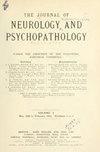Psychopathology
引用次数: 0
Abstract
THis investigation substantiates Rorschach's statement that colour-form answers measure affective instability, and primary-colour responses impulsiveness, usually pathological impulsiveness. The kinesthetic and colour-answers together show the subject's type, his capacity for affective adaptation, for emotional stability and instability-in general, the balance of his emotional life. That the Rorschach test does give a good working knowledge of the subject's temperament as a whole is not doubted by anyone who has used the test. The qualitative aspect is even more important than the quantitative, as often the content of an abnormal subject's answers is full of their symptomatic tendencies shown both overtly and symbolically. It is claimed that the colourand kinaesthetic responses are dependent on the unconscious for their content. These results and those of other investigators suggest that this panoramic view of the subject's temperament as a whole is an advance on the method of measuring temperament and intelligence separately.精神病理学
这项研究证实了罗夏的说法,即颜色形式的回答衡量情感不稳定性,以及原色反应的冲动性,通常是病态冲动性。动觉答案和色彩答案一起显示了受试者的类型,他的情感适应能力,情绪稳定和不稳定的能力,总的来说,他的情感生活的平衡。罗夏测试确实提供了对被试整体气质的有效了解,这是任何使用过该测试的人都不会怀疑的。定性方面甚至比定量方面更重要,因为通常异常受试者的回答内容充满了他们的症状倾向,无论是公开的还是象征性的。据称,颜色和动觉反应的内容依赖于无意识。这些结果和其他研究者的结果表明,这种将被试的气质作为一个整体的全景视图是对气质和智力分开测量方法的一种进步。
本文章由计算机程序翻译,如有差异,请以英文原文为准。
求助全文
约1分钟内获得全文
求助全文

 求助内容:
求助内容: 应助结果提醒方式:
应助结果提醒方式:


